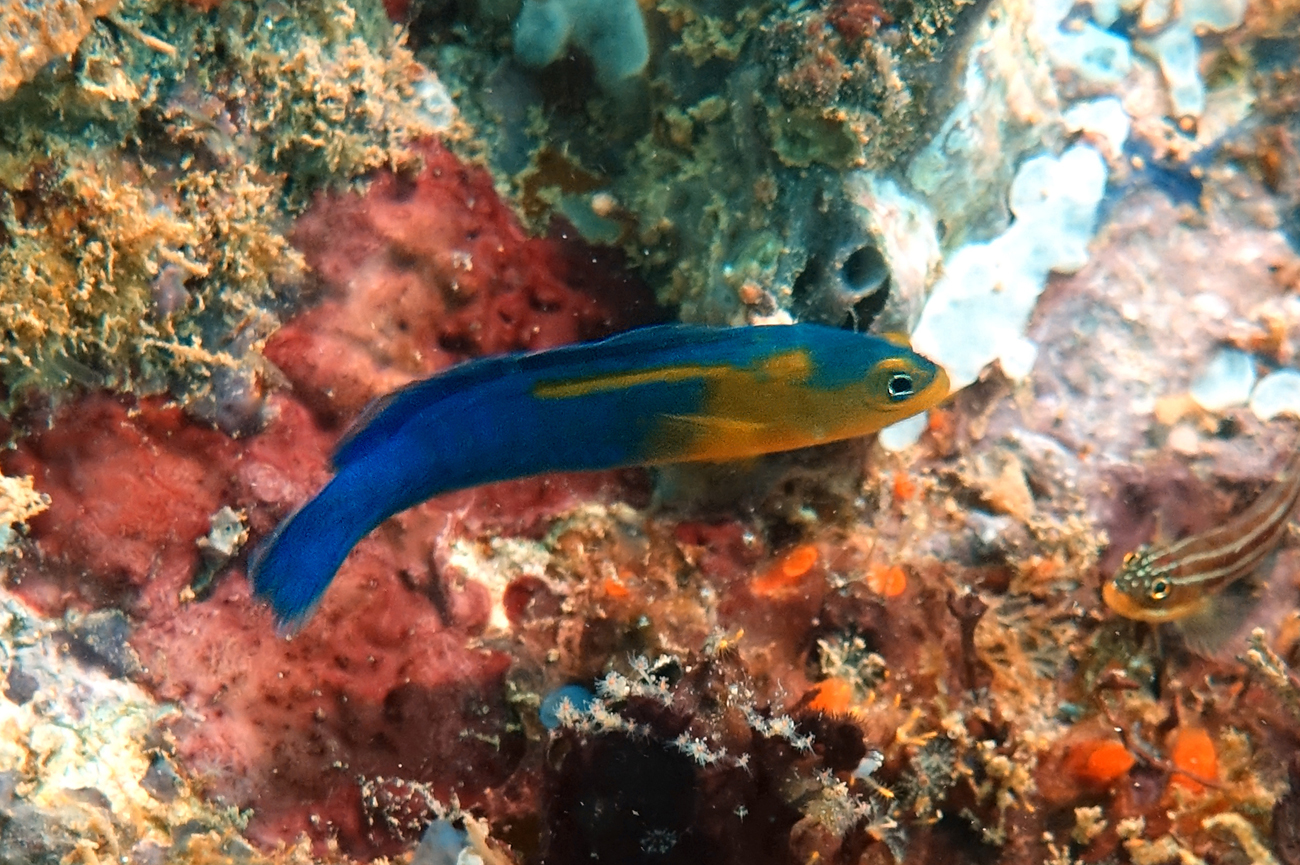Yellowhead Dottyback, Pseudochromis cyanotaenia Bleeker 1857
Other Names: Bluebarred Dottyback, Blue-barred Dottyback

A male Yellowhead Dottyback, Pseudochromis cyanotaenia, at Navy Pier, North West Cape, Western Australia, January 2018. Source: Alex Hoschke / iNaturalist.org. License: CC by Attribution-NonCommercial
Summary:
Males are deep blue with a yellow area extending from the lower part of the head to the pectoral fin, a yellow stripe along the lateral line, and a series of narrow light blue bars along the side. Females are uniformly grey to bluish-grey or reddish-brown, sometimes becoming yellowish or reddish on the tail.
Cite this page as:
Bray, D.J. 2021, Pseudochromis cyanotaenia in Fishes of Australia, accessed 20 Apr 2024, https://fishesofaustralia.net.au/home/species/3463
Yellowhead Dottyback, Pseudochromis cyanotaenia Bleeker 1857
More Info
|
Distribution |
Point Quobba to North West Cape, and offshore reefs of north Western Australia, Ashmore Reef in the Timor Sea, and the far northern Great Barrier Reef, Queensland, and reefs in the Coral Sea, to Cook Island, northern New South Wales. Elsewhere the species occurs in the tropical western-central Pacific. Found on coral and rocky reefs, with pairs inhabiting tide pools, reef flats, lagoonal patch reefs and reef slopes, most commonly in areas with strong currents and surge. This secretive species shelters in holes and crevices. |
|
Features |
Dorsal fin III,21-23 (anterior spine tiny); Anal fin III,12-14: Pectoral fin 17-19; Pelvic fin I,5; Gill rakers 3-5 + 10-11 = 13-16; Lateral line (disjunct) 24-31 anterodorsal series) + 6-11 (peduncular series); Circumpeduncular scales 16; Vertebrae 10+16. Body relatively slender; distance from dorsal-fin origin to pelvic-fin origin 25-28% SL. Lower lip either uninterrupted at symphysis, or with weak interruption only. Vomerine teeth relatively large, arranged in a chevron. Dorsal and anal fins without distinct scaly sheath; caudal fin rounded; |
|
Feeding |
Feeds on small crustaceans, including crabs, isopods, and copepods. |
|
Biology |
Dottybacks are protogynous hermaphrodites, and capable of bi-directional sex change. The form small harems with a dominant male and several females. |
|
Etymology |
The specific name cyanotaenia is from the Greek kyanos (= light blue) and the Latin taenia (= ribbon, band), in reference to the pale blue bars on the sides of males. |
|
Species Citation |
Pseudochromis cyanotaenia Bleeker 1857, Natuurkundig Tijdschrift voor Nederlandsch Indië 13: 72. Type locality: Kajeli, Buru Island, Moluccas, Indonesia. |
|
Author |
Bray, D.J. 2021 |
|
Resources |
Yellowhead Dottyback, Pseudochromis cyanotaenia Bleeker 1857
References
Allen, G.R. 1997. Marine Fishes of Tropical Australia and South-east Asia. Perth : Western Australian Museum 292 pp. 106 pls.
Allen, G.R. & Erdmann, M.V. 2012. Reef fishes of the East Indies. Perth : Tropical Reef Research 3 vols, 1260 pp.
Allen, G.R. & Swainston, R. 1988. The Marine Fishes of North-Western Australia. A field guide for anglers and divers. Perth, WA : Western Australian Museum vi 201 pp., 70 pls. (as Pseudochromis tapeinosoma)
Bleeker, P. 1857. Tweede bijdrage tot de kennis der ichthyologische fauna van Boeroe. Natuurkundig Tijdschrift voor Nederlandsch Indië 13: 55-82
Gill, A.C. 1995. Identification of the primary types of pseudochromine species described by Pieter Bleeker, with lectotype designations for Pseudochromis tapeinosoma and P. xanthochir (Perciformes: Pseudochromidae). Copeia 1995(1): 243-246
Gill, A.C. 1999. Family Pseudochromidae. pp. 2557-2577 in Carpenter, K.E. & Niem, T.H. (eds). The Living Marine Resources of the Western Central Pacific. FAO Species Identification Guide for Fisheries Purposes. Rome : FAO Vol. 4 pp. 2069-2790.
Gill, A.C. 2004. Revision of the Indo-Pacific dottyback fish subfamily Pseudochrominae (Perciformes: Pseudochromidae). Smithiana, Publication in Aquatic Biodiversity, Monographs 1: 1-213 See ref at BHL
Gill, A.C. & Allen, G.R. 1996. Pseudochromis viridis, a new species of dottyback from Christmas Island, Indian Ocean (Teleostei: Perciformes: Pseudochromidae). Revue Française d'Aquariologie et Herpétologie 23(1-2): 33-38
Johnson, J.W. 2010. Fishes of the Moreton Bay Marine Park and adjacent continental shelf waters, Queensland, Australia. pp. 299-353 in Davie, P.J.F. & Phillips, J.A. Proceedings of the Thirteenth International Marine Biological Workshop, The Marine Fauna and Flora of Moreton Bay. Memoirs of the Queensland Museum 54(3)
Kuiter, R.H. 1996. Guide to Sea Fishes of Australia. A comprehensive reference for divers and fishermen. Sydney, NSW, Australia : New Holland Publishers xvii, 434 pp.
Kuiter, R.H. & Tonozuka, T. 2001. Indonesian Reef Fishes. Part 1. Eels - Snappers, Muraenidae - Lutjanidae. Australia : Zoonetics pp. 1-302.
Lowe, G.R. & Russell, B.C. 1990. Additions and revisions to the checklist of fishes of the Capricorn-Bunker Group, Great Barrier Reef, Australia. Great Barrier Reef Marine Park Authority. Special Publication Series 19: 1-27
Randall, J.E., Allen, G.R. & Steene, R. 1990. Fishes of the Great Barrier Reef and Coral Sea. Bathurst : Crawford House Press 507 pp. figs.
Randall, J.E., Allen, G.R. & Steene, R. 1997. Fishes of the Great Barrier Reef and Coral Sea. Bathurst : Crawford House Press 557 pp. figs.
Sadovy de Mitcheson, Y. & Liu, M. 2008. Functional hermaphroditism in teleosts. Fish and Fisheries 9(1): 1-43 https://doi.org/10.1111/j.1467-2979.2007.00266.x
Smith-Vaniz, W.F. 2016. Pseudochromis cyanotaenia (errata version published in 2017). The IUCN Red List of Threatened Species 2016: e.T69583414A115465548. https://dx.doi.org/10.2305/IUCN.UK.2016-3.RLTS.T69583414A69583524.en. Downloaded on 29 November 2021.
Wittenrich, M.L. & Munday, P.L. 2005. Bi-directional sex change in coral reef fishes from the family Pseudochromidae: an experimental evaluation. Zoological Science 22: 797-803. https://doi.org/10.2108/zsj.22.797



